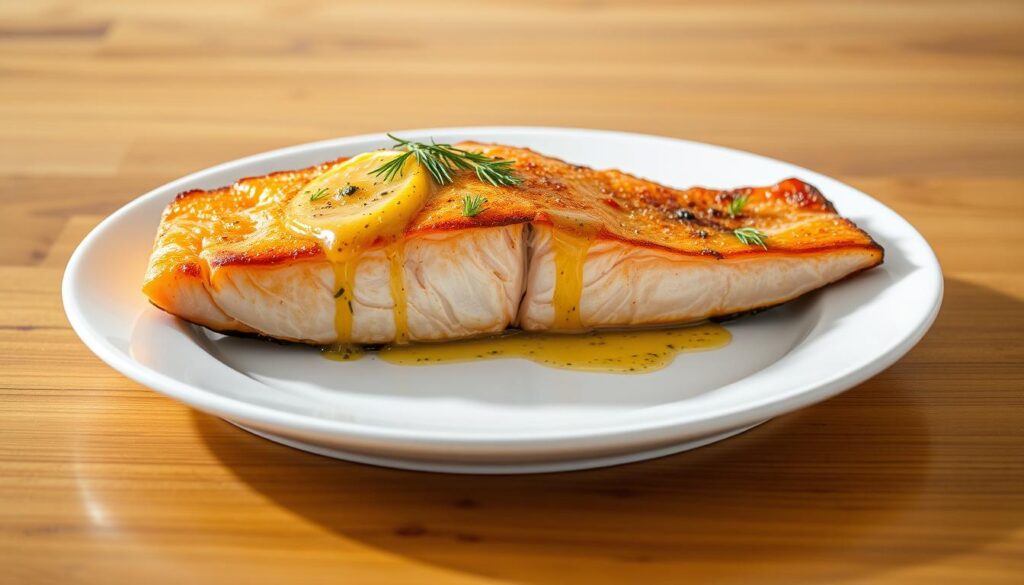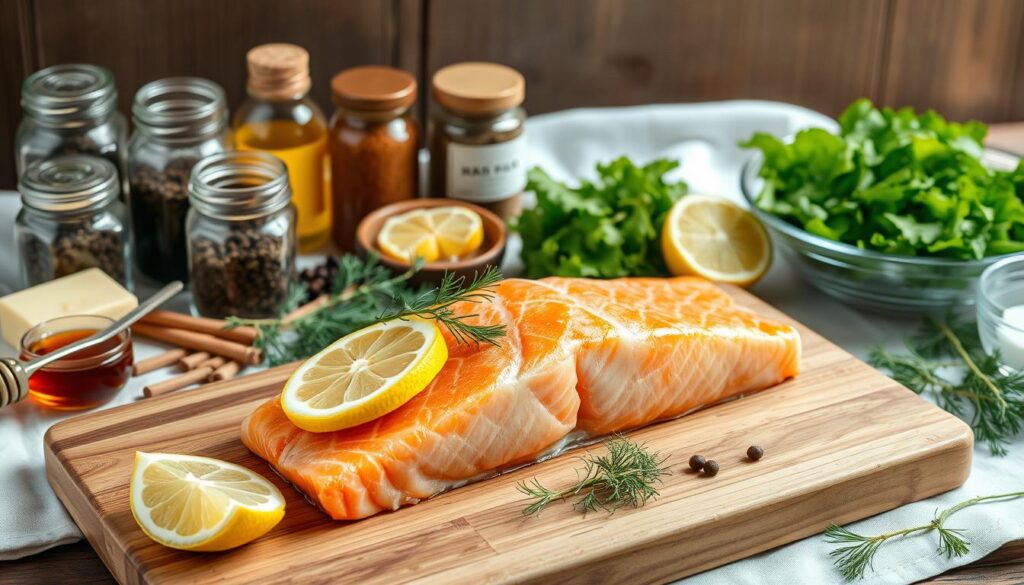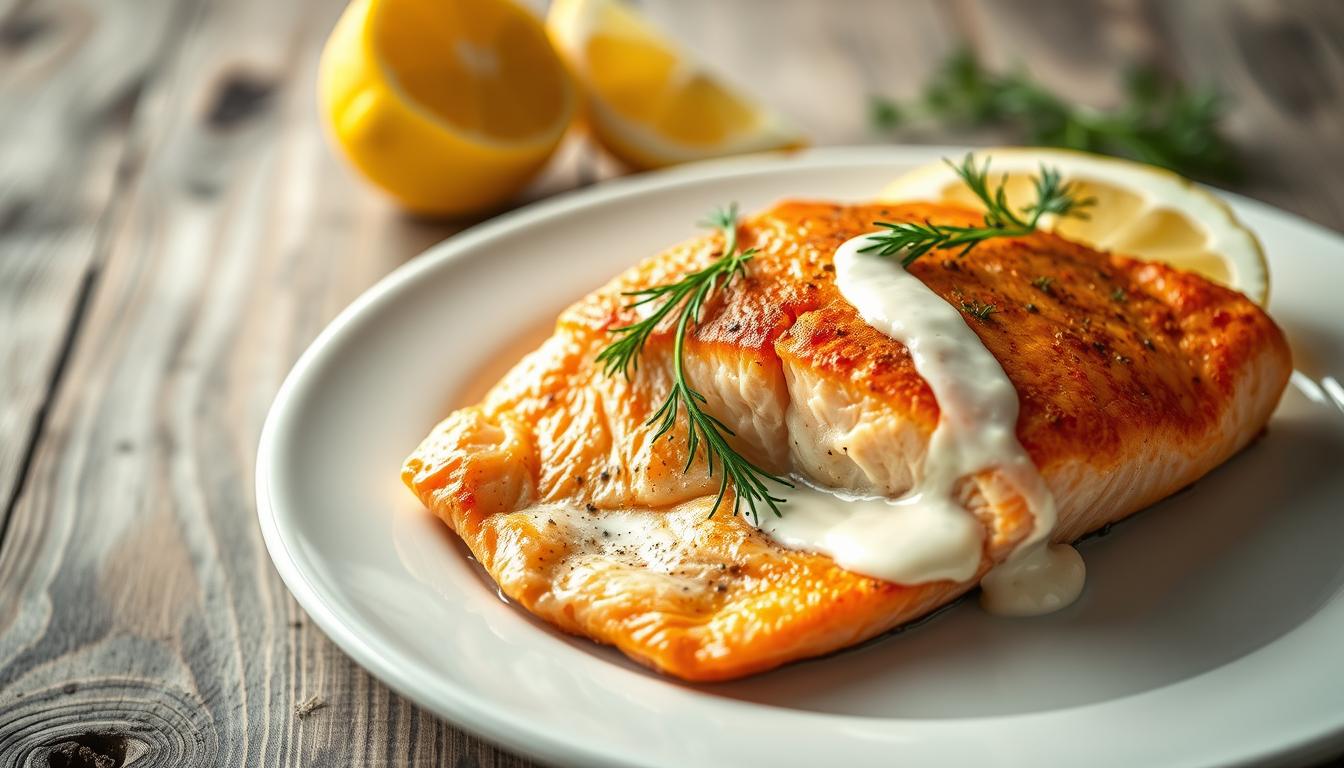Best Ever Baked Salmon Recipe
Table of Contents
Cooking the perfect salmon dish can be tricky. But with the right tips, you can make a dish that wows everyone.
Imagine a tender, flavorful salmon fillet. It’s cooked just right in the oven, with a crispy outside and a juicy inside.
There are many salmon recipes out there. But we’ll show you how to make the best baked salmon recipe.
Key Takeaways
- Learn the secrets to cooking the perfect baked salmon
- Discover the benefits of baking salmon for a healthy meal
- Explore various salmon recipes to suit your taste preferences
- Get tips on how to achieve a crispy exterior and a juicy interior
- Understand the importance of using fresh and high-quality ingredients
The Perfect Baked Salmon: An Overview
Baked salmon is a top pick for healthy eating. It’s not just tasty, but also packed with nutrients. This makes it a fantastic choice for a balanced diet.
This dish is full of protein, omega-3 fatty acids, and important vitamins and minerals. It’s a nutritional powerhouse that boosts heart health, brain function, and fights inflammation.
Why Salmon is a Nutritional Powerhouse
Salmon is loaded with nutrients that are key for good health. It’s a top source of omega-3 fatty acids, which are vital for the heart and brain. It also has vitamin D, selenium, and protein, making it a complete food.
| Nutrient | Benefit |
|---|---|
| Omega-3 Fatty Acids | Supports heart health and brain function |
| Protein | Essential for muscle repair and growth |
| Vitamin D | Crucial for bone health and immune function |
What Makes This Recipe Special
This baked salmon recipe is special because it’s simple and flavorful. We use fresh herbs and light seasoning to bring out the salmon’s natural taste. This makes the dish both delicious and easy to prepare.

Essential Ingredients for the Best Baked Salmon Recipe
The key to a tasty baked salmon recipe is in its ingredients. You need to pick the right ones for flavor and health.
Selecting the Right Salmon
Choosing the right salmon is key. The type you pick affects the taste and texture of your dish.
Wild vs. Farm-Raised Options
Wild salmon tastes richer and is firmer. Farm-raised salmon is cheaper and milder. Think about what you want when you decide.
Best Salmon Cuts for Baking
For baking, use fillets or steaks. They cook well and are easy to season.
Fresh vs. Frozen Salmon: What to Choose
Frozen salmon is often as fresh as it gets. Fresh salmon should be cooked right away.
Key Seasonings and Flavor Enhancers
Some seasonings and enhancers make your salmon stand out. They can turn a simple dish into a hit.
Essential Herbs and Spices
Herbs like thyme and rosemary, and spices like black pepper and paprika, add depth.
Low Sodium Soy Sauce and Other Marinades
Low sodium soy sauce or marinades add a savory taste. Try mixing it with honey for a honey mustard salmon twist.
| Ingredient | Purpose | Example |
|---|---|---|
| Salmon | Main ingredient | Wild or farm-raised salmon fillets |
| Herbs and Spices | Flavor enhancers | Thyme, rosemary, black pepper |
| Low Sodium Soy Sauce | Marinade | Used for salmon soy sauce flavor |

Kitchen Tools You’ll Need
To make the perfect baked salmon, you need the right tools. Here’s what you’ll need to prepare and bake your salmon just right.
Baking Essentials
Here are the basic tools for baking salmon:
- A baking sheet: This is where you’ll place your salmon fillets for baking. Make sure it’s big enough for all the salmon in one layer.
- Parchment paper or aluminum foil: Using parchment paper or aluminum foil on your baking sheet makes cleanup easy. It also stops the salmon from sticking.
- Oven: You’ll need a good oven to bake your salmon. Make sure it’s hot before you put the salmon in.
Optional Equipment for Advanced Techniques
If you want to try more advanced techniques, consider these tools:
- Thermometer: A thermometer helps you check if your salmon is cooked right. It makes sure it’s safe to eat.
- Fish scaler or tweezers: If your salmon has bones, a fish scaler or tweezers can help remove them. This makes your salmon easier to cook.
- Basting brush: If you’re using glazes or sauces, a basting brush helps spread them evenly.
With these tools, you’ll be ready to bake salmon perfectly. Happy baking!
Preparing Your Salmon Before Cooking
To get the best results with your baked salmon, preparation is crucial. It ensures your salmon cooks evenly and tastes great.
Thawing Frozen Salmon Properly
Thawing frozen salmon correctly is key. The best way is to thaw it in the fridge overnight. If you’re in a hurry, thaw it under cold running water, changing the water every 30 minutes.
Never thaw salmon at room temperature or in hot water. This can cause bacterial growth and foodborne illness.
Removing Pin Bones
Before cooking, remove the pin bones from your salmon fillet. These small bones run along the fish’s lateral line. Use tweezers or needle-nose pliers to gently pull them out.
Portioning Your Salmon
Portioning your salmon into individual servings makes cooking and serving easier. Use a sharp knife to cut the fillet into equal pieces.
| Portion Size | Cooking Time |
|---|---|
| 6 oz | 12-15 minutes |
| 8 oz | 15-18 minutes |
| 10 oz | 18-20 minutes |
The Ultimate Baked Salmon Recipe: Step-by-Step Guide
Cooking baked salmon is easier than you think. It just needs a few steps: preheat your oven, season the salmon, and bake at the right temperature and time.
Preheating and Setting Up
First, preheat your oven to 400°F (200°C). While it heats up, get your baking sheet ready. Line it with parchment paper or aluminum foil for easy cleanup. A light coat of olive oil can also prevent sticking.
Seasoning Your Salmon
Seasoning is where you can get creative. Here are two ways to do it:
Basic Seasoning Approach
For a simple yet tasty dish, sprinkle salt, pepper, and herbs (like thyme or rosemary) on both sides of the salmon. A squeeze of lemon juice adds brightness.
Creating a Flavorful Crust
For more flavor, mix minced garlic, chopped parsley, and lemon zest. Brush this mixture over the salmon. It adds flavor and creates a delicious crust.
Baking Times and Temperatures
The baking time and temperature are key for perfectly cooked salmon. Here’s what you need to know:
Standard Oven Method
Bake the salmon at 400°F (200°C) for 12-15 minutes per pound. It should reach an internal temperature of 145°F (63°C). Cooking time depends on the salmon’s thickness.
Convection Oven Adjustments
In a convection oven, bake at 375°F (190°C) for 8-12 minutes per pound. This method cooks more evenly and crisps the exterior.
| Oven Type | Temperature | Cooking Time per Pound |
|---|---|---|
| Standard Oven | 400°F (200°C) | 12-15 minutes |
| Convection Oven | 375°F (190°C) | 8-12 minutes |
By following these steps, you’ll get a delicious baked salmon. This guide is perfect for beginners and experienced cooks alike, ensuring perfect results every time.
Classic Flavor Variations
Make your baked salmon even better with these classic flavors. Choose from sweet and tangy to savory and umami. These flavors will take your dish to the next level.
Honey Mustard Glazed Salmon
A honey mustard glaze gives your salmon a sweet and tangy taste. Mix honey, Dijon mustard, salt, and pepper for the glaze. Brush it on the salmon in the last few minutes of baking for a golden finish. This honey mustard salmon is loved by many and goes great with roasted veggies.
Soy Sauce and Ginger Infusion
For an Asian twist, try a soy sauce and ginger infusion. Combine soy sauce, grated ginger, and brown sugar for a marinade. This salmon soy sauce mix is perfect for those who love umami. It’s great with steamed bok choy or stir-fried veggies.
Lemon Herb Butter Salmon
A compound butter with lemon zest, chopped herbs (like parsley or dill), and butter adds a rich, citrusy taste. Just mix these and spread the lemon herb butter on your salmon before baking. It makes the salmon moist and flavorful, impressing everyone.
| Flavor Variation | Key Ingredients | Pairing Suggestions |
|---|---|---|
| Honey Mustard Glazed | Honey, Dijon Mustard | Roasted Vegetables |
| Soy Sauce and Ginger | Soy Sauce, Ginger | Steamed Bok Choy |
| Lemon Herb Butter | Lemon Zest, Herbs, Butter | Garlic Mashed Potatoes |
How to Tell When Your Salmon is Perfectly Cooked
Knowing when your salmon is done is key for safety and taste. You can use visual signs and exact temperature checks to get it right.
Visual Indicators of Doneness
Look at the salmon’s color and texture to see if it’s cooked. It should be white and flake with a fork. If it’s still pink or hard, it needs more time.
Using a Thermometer for Precision
For exactness, use a meat thermometer. It ensures your salmon is at a safe temperature.
Ideal Internal Temperatures
The USDA says to cook salmon to 145°F (63°C). But chefs often aim for 125°F (52°C) for a juicier taste.
Carryover Cooking Considerations
Remember, salmon will cook a bit more after it’s out of the oven. So, take it out at 130°F (54°C) for a medium-rare finish.
| Cooking Method | Internal Temperature | Doneness Level |
|---|---|---|
| Baking | 125°F – 130°F | Medium-Rare |
| Baking | 145°F | Well Done |
Common Mistakes to Avoid When Baking Salmon
When baking salmon, it’s key to avoid common mistakes. Overcooking and seasoning issues are two big ones. Overcooking makes the salmon dry and tough. Bad seasoning can mess up the flavor.
Overcooking Issues and Solutions
To prevent overcooking, watch the cooking time and temperature closely. The salmon should be cooked to an internal temperature of 145°F to 150°F.
Seasoning Pitfalls
Balancing Salt and Acid
A good seasoning mix might include salt, pepper, and a bit of lemon juice or vinegar. This adds balance to the flavor.
When to Add Delicate Herbs
Herbs like parsley, dill, or basil can really enhance the salmon’s flavor. But, add them towards the end of cooking. This way, they keep their freshness and flavor.
Healthy Side Dishes to Complement Your Baked Salmon
When you’re enjoying a delicious baked salmon, it’s great to have some tasty and healthy side dishes to go with it. These dishes not only add flavor but also provide essential nutrients to make your meal complete. Here are some fantastic options to consider:
1. Roasted Vegetables
Roasting vegetables brings out their natural sweetness and adds a delightful caramelized flavor. Try roasting carrots, Brussels sprouts, or asparagus with a drizzle of olive oil and a pinch of salt and pepper. This side dish is not only delicious but also packed with vitamins and minerals.
2. Quinoa Salad
Quinoa is a protein-rich grain that pairs perfectly with salmon. Create a quinoa salad by mixing cooked quinoa with chopped veggies like cucumbers, tomatoes, and bell peppers. Add a tangy dressing made from lemon juice, olive oil, and a hint of honey for a refreshing and nutritious side dish.
3. Steamed Broccoli
Steaming broccoli preserves its nutrients and gives it a tender texture. Simply place broccoli florets in a steamer basket and steam them until they’re tender but still crisp. Season with a squeeze of lemon juice and a sprinkle of garlic powder for added flavor.
4. Sautéed Spinach
Spinach is a nutrient-dense leafy green that complements the flavors of salmon beautifully. Sauté chopped spinach with garlic, lemon juice, and a bit of olive oil until it’s wilted but still vibrant. This side dish is not only healthy but also bursting with flavor.
5. Brown Rice
Brown rice is a great source of fiber and pairs well with the delicate flavors of salmon. Cook brown rice according to package instructions and season with a bit of olive oil, salt, and pepper. You can also add some chopped herbs like parsley or thyme for extra flavor.
These healthy side dishes offer a variety of textures, flavors, and nutrients to complement your baked salmon. Whether you’re a fan of roasted vegetables, quinoa salads, steamed broccoli, sautéed spinach, or brown rice, there’s something for everyone to enjoy. So, next time you’re serving baked salmon, try incorporating one or more of these delicious and nutritious side dishes to make your meal even more satisfying.
Storing and Reheating Leftover Salmon
Storing and reheating leftover salmon needs care to keep its taste and texture. Using the right methods ensures you enjoy it just as much as the first time.
Proper Storage Techniques
Keeping leftover salmon fresh is key. You can use refrigeration or freezing to keep it good.
Refrigeration Guidelines
Put leftover salmon in the fridge within two hours of cooking. Use an airtight container and keep it cold. It stays good for three days.
Freezing Methods
Freezing is great for longer storage. Wrap it well in plastic or foil and put it in a freezer bag. It can last up to three months in the freezer.
Reheating Methods That Maintain Moisture
There are ways to reheat leftover salmon that keep it moist. Try gentle oven reheating or stovetop methods.
Gentle Oven Reheating
Heat your oven to 275°F (135°C). Put the salmon on a lined baking sheet, cover with foil, and warm for 10-15 minutes.
Stovetop Techniques
Warm the salmon in a skillet over low heat. Add a bit of water or broth to keep it moist. Cover and heat for 5-8 minutes.
| Storage Method | Duration | Reheating Tip |
|---|---|---|
| Refrigeration | Up to 3 days | Gentle oven reheating |
| Freezing | Up to 3 months | Stovetop reheating with moisture |
Creative Ways to Use Leftover Baked Salmon
Give leftover baked salmon a new life with these creative dishes. Instead of reheating, why not turn it into something new? You can make salads, patties, and more.
Salmon Salads and Bowls
Make a refreshing salad with leftover salmon. Mix it with greens, cherry tomatoes, and a citrus vinaigrette. Or, try a salmon salad with Greek yogurt, cucumber, and dill on quinoa or brown rice.
For a quick meal, create a salmon bowl. Add leftover salmon, roasted veggies, and your favorite sauce.
Salmon Patties and Croquettes
Make tasty salmon patties or croquettes with leftover salmon. Flake the salmon, mix with panko breadcrumbs, egg, and seasonings. Shape into patties or balls. Pan-fry until crispy.
| Recipe | Main Ingredients | Prep Time |
|---|---|---|
| Salmon Salad | Leftover salmon, mixed greens, citrus vinaigrette | 10 minutes |
| Salmon Patties | Leftover salmon, panko breadcrumbs, egg | 15 minutes |
| Salmon Bowl | Leftover salmon, roasted vegetables, quinoa | 20 minutes |
Conclusion
## Conclusion
Baking salmon is easy and makes a delicious, moist dish. This simple recipe will help you cook salmon perfectly. You can also try different flavors and sides to make your salmon even better.
Follow the steps in this guide to cook salmon every time. This recipe is great for both experienced cooks and beginners. So, try it out and enjoy the taste!
We’ve talked about how to make great baked salmon. Now, it’s time to try it yourself. Enjoy the rich flavors of perfectly cooked salmon.
For more ideas on sides and using leftover salmon, check out online articles and recipes. Happy cooking!

